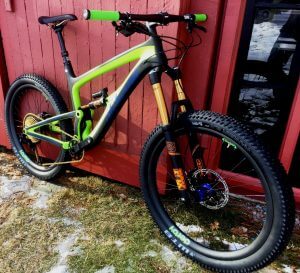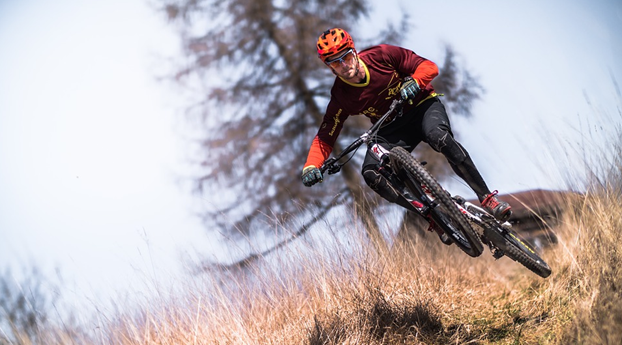Mountain Biking 101: Basic Riding Techniques & Tips for Buying Your First MTB
By Amanda Wilks
Mountain bikes are versatile as they can be ridden on all kinds of terrain. They provide a fun way to exercise while connecting with nature. However, if it’s your first time going mountain biking, it can be a little daunting choosing the right bike.
The text below highlights some important things to keep in mind when selecting your first mountain bike as well as some appropriate riding techniques and accessories for beginners.
Types of Mountain Bikes
Mountain bikes are categorized into four broad categories:

- Cross-country (XC) bikes designed for fast racing
- Trail bikes for all-round mountain biking
- Enduro bikes for technical terrain
- Downhill (DH) bikes for descending only
XC mountain bikes are the lightest, provide the least suspension, and are designed with steeper geometrics to maximize handling and rider positioning for climbing. DH bikes, on the other hand, feature extremely slack geometries and a full suspension that is ideal for riding downhills and with almost no emphasis on pedaling efficiency. XC and DH bikes are designed for specific use and have a narrower range of function than a Trail bike.
For these reasons, most beginners should consider purchasing a Trail based full suspension bike or, for those on a tighter budget, a Plus tire based “hardtail” mountain bike without any rear suspension.
A properly set-up Trail based full suspension bike will have plenty of travel for fast technical descents with little to no compromise when it comes to climbing ability. In fact, some of the best suspension systems actually help you climb better too by maximizing traction.
If full suspension is more than you are looking for at this time, “Plus” tire equipped hardtail bikes, with their wider tires and lower pressure, also provide a nice stable platform with excellent traction at a lower price. Think of a good suspension system or a Plus tire like the fat ski equivalent in biking. They just make learning to ride easier and inspire confidence.
Mountain Bike Wheel Size
There are a wide range of mountain bike wheels on the market these days. Today, most mountain bike wheels are based on 27.5” or 29” diameters. These two sizes have primarily replaced the popular twenty-six-inch wheel size that was the standard for many years.
While there are arguments about which wheel diameter is better (29” wheels carry speed and roll over things better, 27.5” can be more nimble and stronger…), most novice riders will be well suited to choose a wheelsize (and bike type) that is proportionate and well suited to them. For example, 29” wheel bikes can often have some fit limitations for small riders in particular and many smaller riders would be best served by a 27.5” wheel bike.
As mentioned above, there are also wider “Plus” sized tires available on some bikes. Along with the additional width, a “Plus” tire has a bigger diameter than a standard width tire. Thus a 27.5” bike equipped with a 3.0” width Plus tire will have a similar diameter to a 29” bike equipped with a standard 2.1 or 2.2” tire. Needless to say, a 29” Plus tire is thus quite big… A “Plus” compatible bike frame is required to use “Plus” tires.
Mountain Bike Frame Materials
There are four primary materials bikes are made of with aluminum and carbon fiber being the most popular on mountain bikes. A brief breakdown of the materials is as follows:
- Steel frames are known for their strength, comfort, durability and affordable price, but can be heavy compared to the other materials at lower price points. There are few good quality mass produced mountain bikes currently being made out of steel.
- Titanium frames don’t corrode, are notably lighter than steel, and often offer a lively feeling with great durability. This being said, there are few full suspens

Carbon Fiber Felt Edict ion titanium mountain bikes on the market.
- Aluminum is a common material for the first tiers of modern-day mountain bike frame manufacture as it is light, durable, stiff and relatively inexpensive. Aluminum is also a good material to develop pivots and hardware for full suspension components and thus most full suspension bikes have at least some aluminum in their frame.
- Carbon fiber frames are often the lightest and most responsive and can have excellent high frequency vibration absorbing properties. A carbon fiber mountain bike will cost more than an aluminum bike, but will often maximize the performance of the bike.
There are many different quality grades within materials. More detailed information on carbon fiber fabrication and quality can be found here.
Basic Mountain Bike Riding Techniques for Beginners
While biking on mountainous terrain is fun, beginners need to get acquainted with basic skills that are necessary to be safe and confident:
- Braking
Before braking, riders should become familiar with the amount of force they need to exert on the brake levers. Bigger and heavier tires require more braking power than lighter ones and hydraulic braking systems are more powerful than cable driven systems. When riding downhill, apply the brakes evenly between the front and rear wheel – remembering that your front brake provides the most stopping power. Be sure to shift your weight back over the rear wheel to increase braking power and balance during descents.
- Riding Downhill
When descending, relaxing and remaining loose and calm are keys. Be sure to remain relaxed without clenching the grip or making your arms and shoulders rigid. Your elbows should bend along

with the bumps to absorb the shock while your hands should allow a relaxed, yet controlled grip to provide balance and consistency.
When riding along bumpy terrain, let your knees and legs absorb the rocky trails. If cycling on extremely steep descents, consider dropping the saddle two to three inches to lower your center of gravity and provide adequate room for you to maneuver above the bike. Dropper seatposts allow the seat height to be adjusted while you ride and make descending easier.
- Riding Uphill
As you enter a hill, briefly ease off the pedals slightly to help the bike shift into a lower gear. It is important to determine the best gear that matches up the steepness of the climb and terrain.
While standing out of the saddle allows you to climb steep hills faster, standing can cause the rear tire to lose grip and spin out and uses more energy than sitting. When cycling on steep hills, lean forward and add a little weight to the front wheel to keep it grounded. For rocky climbs or other rough terrain, the trick is to keep pedaling with the pressure on in a balanced, smooth and rapid cadence fashion. Pedaling slowly and/or eratically only makes you work harder and can diminish traction in the process.
Fundamental Mountain Bike Safety Tips
- Wear a Helmet
Always wear a high-quality and well-adjusted safety helmet to protect your head. Many first-time bikers ignore this essential biking gear. Just remember that a head injury is forever.
- Inspect Your Bike Regularly
Check the brakes to ensure they can stop fast and safely. Inspect the tires and the mechanics of loose or broken parts. Be sure to clean and lubricate the chain regularly to minimize friction and maximize shift performance.
- Wear Appropriate Gear
Apart from the helmet, you also need to wear gloves to protect your hands from blister, knocks, and scrapes. Riding shoes provide extra grip on the pedals, transfer power better, and prevent laces from getting stuck in the chain. A pair of glasses protects your eyes from the sun’s glare and pieces of debris that fly when riding. Riding shorts can reduce friction and offer additional padding and, for those feeling particularly adventurous, protective padding on your joints can cut down the chance of on impact based injury.
Conclusion
Whether you are looking for a mountain bike for a competition or leisure, pick a bike that allows you to enjoy the mountain bike riding experience while sharpening your biking skills. The best place to start your search is at a good bike shop that specializes in fitting and bike set-up.
Contact Fit Werx if you have questions or are interested in finding a new mountain bike.
Amanda Wilks is a professional writer, contributing reviewer for Mountain Bike Reviewed and veteran MTBer. Amanda thinks that mountain biking is both relaxing and healthy, getting people closer to nature. Before accepting an MTB challenge, she always takes all the necessary precautions and safety measures. Find out more about Amanda on Twitter.


